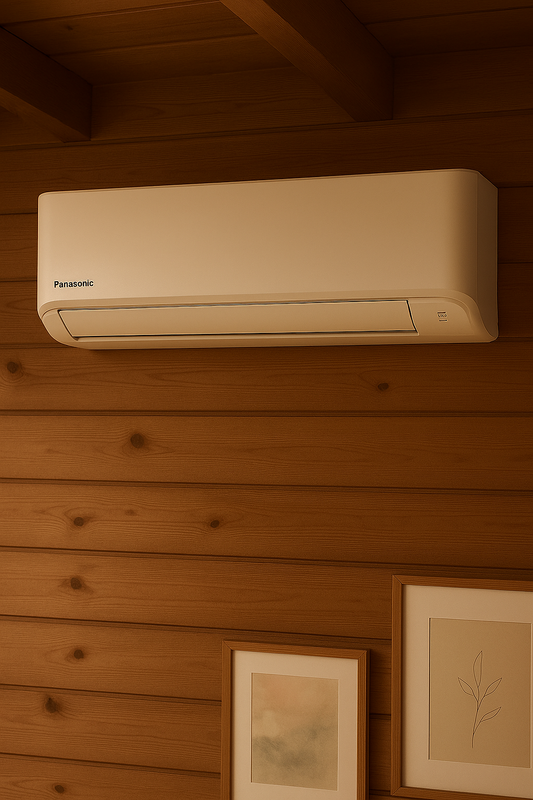Installation av bergvärme
Bergvärme är en energieffektiv och miljövänlig metod för att värma upp hus och byggnader. I denna artikel kommer vi att utforska installationen av bergvärme, inklusive dess definition, fördelar, användningsområden, relaterade tekniker, vanliga frågor och en sammanfattning av dess fördelar.
1. Definition och bakgrund
Bergvärme är en form av geotermisk energi som utnyttjar den naturliga värmen i marken för att värma upp byggnader. Genom att installera en värmepump och en serie av markvärmeslingor, kan värmen från marken användas för att värma upp ett hus under kalla väderförhållanden.
2. Fördelar och användningsområden
Installation av bergvärme erbjuder flera fördelar, inklusive:
- Energieffektivitet: Bergvärme är en av de mest energieffektiva värmemetoderna tillgängliga.
- Miljövänligt: Genom att utnyttja den naturliga värmen i marken minskar bergvärme behovet av fossila bränslen.
- Långsiktig ekonomisk besparing: Även om initialkostnaderna kan vara höga, kan installation av bergvärme leda till långsiktiga besparingar på uppvärmningskostnader.
- Möjlighet till kylning: Utöver uppvärmning kan bergvärme även användas för att kyla hus under varma väderförhållanden.
Bergvärme används främst för att värma upp bostäder, kommersiella fastigheter och offentliga byggnader. Det är särskilt populärt i områden där tillgången på andra energikällor är begränsad eller där miljövänliga alternativ prioriteras.
3. Relaterade tekniker, begrepp eller variationer
En närliggande teknik till bergvärme är sjövärme, som utnyttjar värmen i sjöar eller hav för att värma upp byggnader. Dessutom finns det olika systemkonfigurationer för bergvärme, inklusive horisontella och vertikala markvärmeslingor samt borrhål i marken.
4. Vanliga frågor (FAQ)
Fråga: Vad är den typiska livslängden för en bergvärmepump?
Svar: En värmepump för bergvärme har vanligtvis en livslängd på cirka 15-20 år, men kan vara längre med regelbunden underhållning.
Fråga: Kan bergvärme installeras i alla typer av mark?
Svar: I de flesta fall kan bergvärme installeras i olika marktyper, men vissa geologiska förhållanden kan påverka installationskostnaderna.
5. Sammanfattning
Installation av bergvärme är en effektiv och miljövänlig metod för att värma upp byggnader. Genom att utnyttja den naturliga värmen i marken kan bergvärme erbjuda långsiktiga ekonomiska besparingar och minska beroendet av fossila bränslen.
6. Installation Process
Installation of geothermal heat pumps involves several key steps:
- Site Assessment: An initial survey of the site is conducted to determine the feasibility of geothermal heat pump installation. Factors such as soil composition, land availability, and local regulations are considered.
- Loop System Installation: Depending on the type of loop system chosen (horizontal or vertical), the installation of the ground loop takes place. This involves burying the piping system in the ground to capture the earth's heat.
- Heat Pump Installation: The heat pump unit is installed within the building or property, and the necessary connections to the loop system are established.
- System Testing: Once the installation is complete, thorough testing of the geothermal system is carried out to ensure proper functionality and efficiency.
7. Energy Efficiency Considerations
Geothermal heat pumps are highly efficient, with coefficients of performance (COP) typically ranging from 3.0 to 5.0. This means that for every unit of electricity used to power the system, 3 to 5 units of heat energy are produced. This high level of efficiency results in reduced energy consumption and lower utility bills for the property owner.
8. Environmental Impact
By utilizing the constant thermal energy stored in the earth, geothermal heat pumps significantly reduce greenhouse gas emissions associated with traditional heating systems. The minimal use of electricity for operation further contributes to their environmentally friendly profile.
9. Case Study: Residential Application
In a residential setting, the installation of a geothermal heat pump resulted in a 40% reduction in heating and cooling costs compared to conventional systems. The property owners also benefited from government incentives and tax credits, further enhancing the economic viability of the installation.
10. Maintenance and Longevity
Proper maintenance of geothermal heat pump systems, including regular inspections and loop flushing, can extend the lifespan of the system beyond the typical 20-year mark. With routine care, these systems can provide reliable heating and cooling for decades.
11. Conclusion
Geothermal heat pump installation offers a sustainable solution for heating and cooling needs, with long-term benefits for both the environment and property owners. The versatility and efficiency of these systems make them a compelling choice for residential, commercial, and public applications.
12. Cost Considerations
While geothermal heat pump systems offer long-term savings, the initial installation costs can be higher compared to traditional heating and cooling systems. Factors such as site accessibility, loop system configuration, and property size can impact the overall cost of installation.
13. Retrofitting Existing Buildings
Geothermal heat pump systems can be retrofitted into existing buildings, providing an opportunity to upgrade to more sustainable heating and cooling solutions. However, retrofitting may require modifications to the property and careful integration with the existing infrastructure.
14. Hybrid Systems Integration
Hybrid heating and cooling systems, which combine geothermal heat pumps with supplementary technologies such as solar thermal panels or traditional HVAC units, offer a flexible approach to energy management. This integration can optimize performance and further reduce overall energy consumption.
15. Remote Monitoring and Control
Advanced geothermal heat pump installations may incorporate remote monitoring and control features, allowing property owners to manage and optimize system performance from a centralized platform. This technology can enhance efficiency and facilitate proactive maintenance.
16. Local Regulations and Incentives
Before proceeding with a geothermal heat pump installation, it is essential to research local regulations and incentives. Many regions offer financial incentives, tax credits, or rebates for adopting sustainable heating and cooling technologies, which can offset the initial investment.
17. Industry Innovations
Ongoing advancements in geothermal heat pump technology continue to drive improvements in efficiency, durability, and integration capabilities. Staying informed about industry innovations can help property owners make informed decisions when considering geothermal solutions.
18. Geothermal Heat Pump Sizing
Proper sizing of geothermal heat pump systems is crucial for optimal performance and energy efficiency. Factors such as building size, insulation levels, and local climate conditions are considered to determine the appropriate capacity of the heat pump.
19. Ground Source Heat Exchangers
Ground source heat exchangers are key components of geothermal heat pump systems, facilitating the transfer of heat between the earth and the building. Different configurations, such as closed-loop and open-loop systems, offer flexibility in system design and installation.
20. Geothermal Heat Pump Operation
Geothermal heat pump systems operate by utilizing the stable temperature of the earth to extract heat for heating or to reject heat for cooling. Understanding the operational principles helps property owners maximize the benefits of these systems.
21. Geothermal Heat Pump Performance Monitoring
Continuous monitoring of geothermal heat pump performance allows for early detection of potential issues and ensures efficient operation. Data logging and analysis provide valuable insights into system behavior and energy utilization.
22. Renewable Energy Integration
Geothermal heat pump systems can be integrated with other renewable energy sources, such as wind or solar power, to create a comprehensive and sustainable energy solution for properties. This approach enhances energy resilience and reduces dependence on traditional grid electricity.
23. Geothermal Heat Pump Regulations and Standards
Adherence to industry regulations and standards is essential for the safe and effective installation of geothermal heat pump systems. Compliance with guidelines ensures the quality and performance of the systems while promoting environmental responsibility.
24. Geothermal Heat Pump Benefits for Commercial Buildings
Commercial buildings can benefit significantly from geothermal heat pump installations. These systems offer consistent heating and cooling, resulting in improved comfort for occupants. Additionally, the long-term cost savings and environmental benefits make geothermal heat pumps a compelling choice for sustainable building operations.
25. Geothermal Heat Pump Design Considerations
Designing a geothermal heat pump system involves careful consideration of factors such as building layout, thermal conductivity of the ground, and load calculations. Proper design ensures optimal performance and efficiency of the system.
26. Geothermal Heat Pump Zoning and Distribution
Zoning and distribution systems play a crucial role in maximizing the effectiveness of geothermal heat pumps. Strategic placement of zones and efficient distribution of heated or cooled air contribute to balanced comfort and energy efficiency within the property.
27. Geothermal Heat Pump Retrofit Case Study: Historic Building
In a retrofit project for a historic building, the implementation of a geothermal heat pump system resulted in substantial energy savings and improved climate control without compromising the architectural integrity of the structure. The project serves as a testament to the adaptability of geothermal solutions for diverse building types.
28. Geothermal Heat Pump Performance in Extreme Climates
Geothermal heat pump systems have demonstrated reliable performance in extreme climate conditions, offering consistent heating in cold environments and efficient cooling in hot regions. Their adaptability makes them a viable option for properties located in diverse geographic areas.
29. Geothermal Heat Pump System Financing Options
Property owners exploring geothermal heat pump installations can benefit from various financing options, including loans, leasing arrangements, and energy efficiency programs. Understanding the available financial mechanisms can facilitate the adoption of sustainable heating and cooling solutions.


